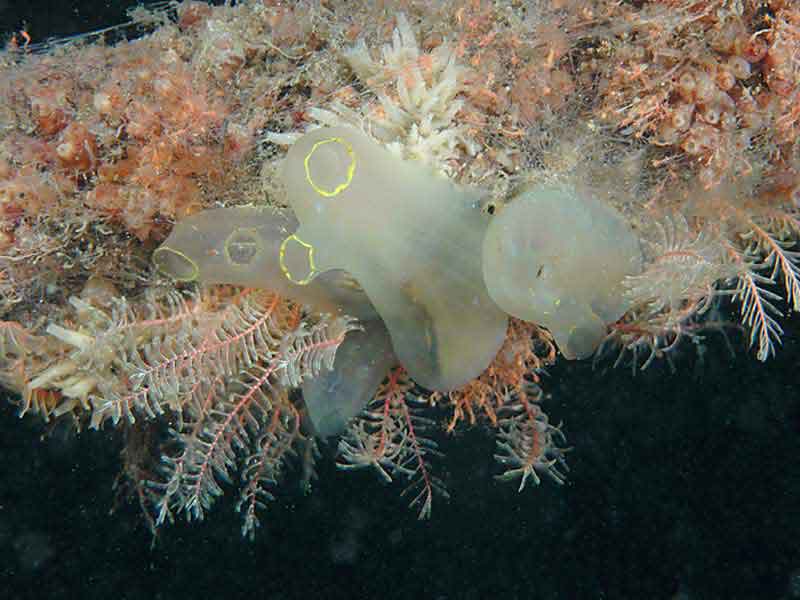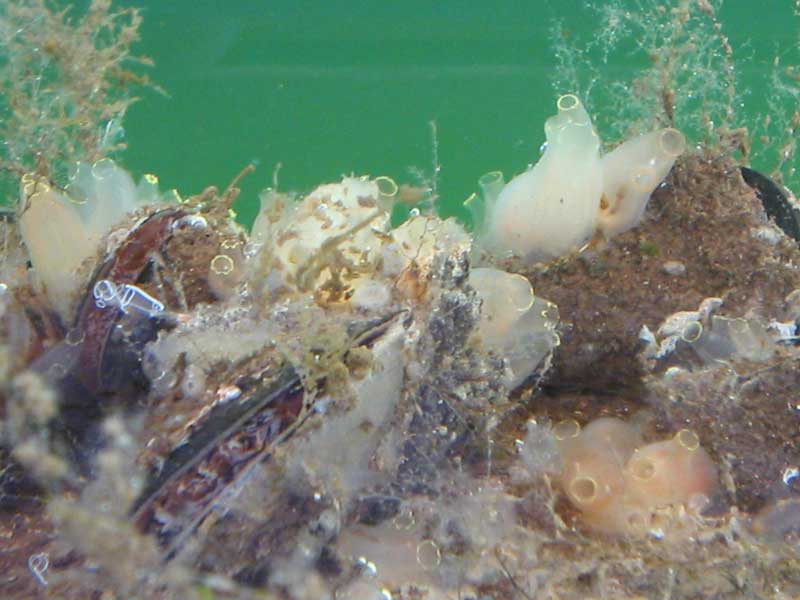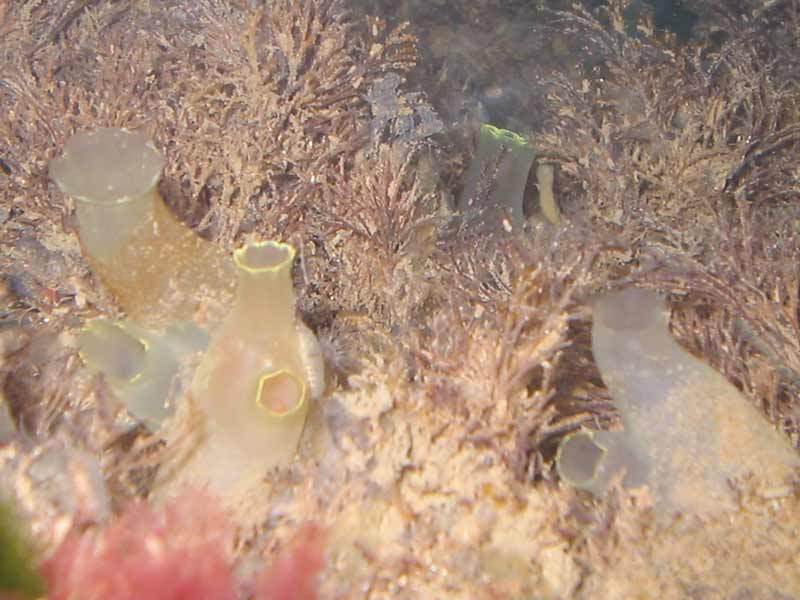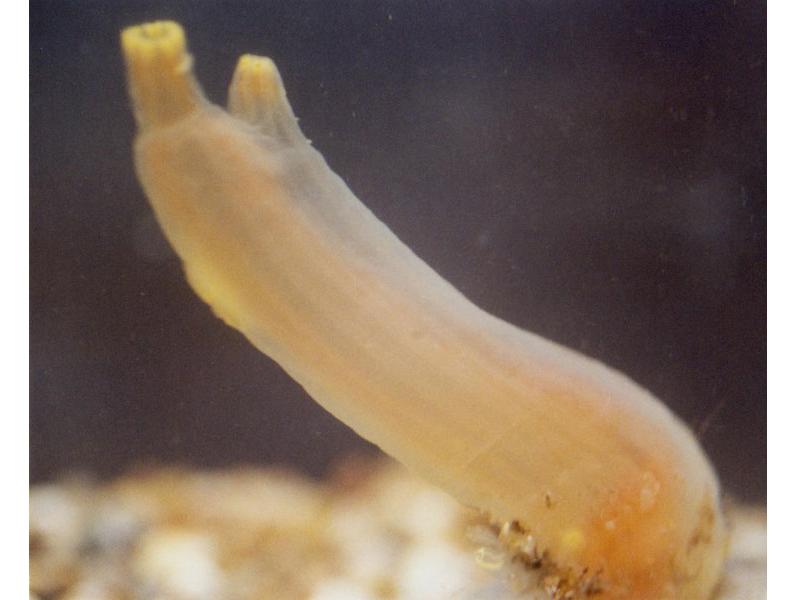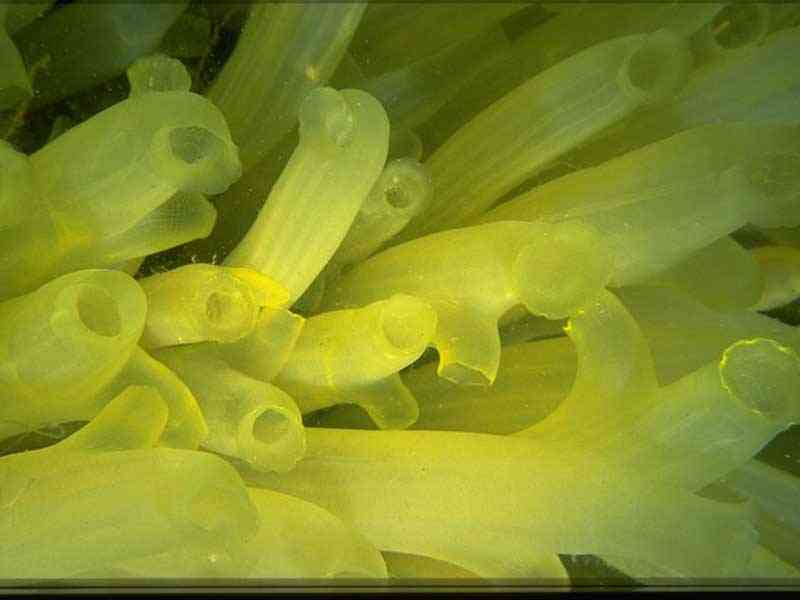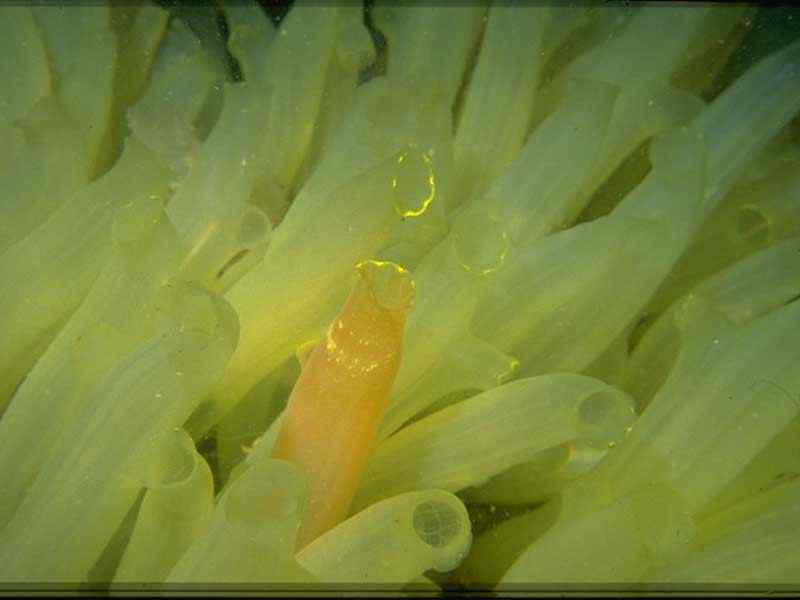Sea vase (Ciona intestinalis)
Distribution data supplied by the Ocean Biodiversity Information System (OBIS). To interrogate UK data visit the NBN Atlas.Map Help
| Researched by | Angus Jackson | Refereed by | Dr John Bishop |
| Authority | (Linnaeus, 1767) | ||
| Other common names | Yellow-ringed sea squirt | Synonyms | - |
Summary
Description
Ciona intestinalis is a large solitary sea squirt which grows up to 15 cm in length. The body is soft, retractile and a pale translucent greenish/yellow, through which the internal organs are visible. Sometimes there are orange bars on the body. There are two openings or siphons which may have yellow margins with orange/red pigment spots.
Recorded distribution in Britain and Ireland
Widely distributed round British and Irish coasts.Global distribution
Widely distributed throughout temperate regions of the world.Habitat
Found from the lower shore down to at least 500 m. Often common in man-made environments such as harbours and marinas. Grows on bedrock and boulders but also artificial surfaces such as metal and concrete. Other species such as algae are also used as substrata. Ciona intestinalis prefers habitats with low wave exposure and some water flow.Depth range
0-500Identifying features
- A large solitary ascidian commonly found in dense, unfused aggregations.
- Body is a translucent pale greenish yellow with or without orange bars.
- Oral (inhalant) siphon is terminal and has 8 lobes.
- Atrial (exhalant) siphon is subterminal and has 6 lobes.
- Siphon lobes may have red-orange pigment spots.
Additional information
Also sometimes known as a sea vase.
Listed by
- none -
Biology review
Taxonomy
| Level | Scientific name | Common name |
|---|---|---|
| Phylum | Chordata | Sea squirts, fish, reptiles, birds and mammals |
| Class | Ascidiacea | Sea squirts |
| Order | Phlebobranchia | |
| Family | Cionidae | |
| Genus | Ciona | |
| Authority | (Linnaeus, 1767) | |
| Recent Synonyms | ||
Biology
| Parameter | Data | ||
|---|---|---|---|
| Typical abundance | Moderate density | ||
| Male size range | |||
| Male size at maturity | |||
| Female size range | Medium (11-20 cm) | ||
| Female size at maturity | |||
| Growth form | Cylindrical | ||
| Growth rate | 10-20mm/month | ||
| Body flexibility | High (greater than 45 degrees) | ||
| Mobility | Sessile, permanent attachment | ||
| Characteristic feeding method | Active suspension feeder, Non-feeding | ||
| Diet/food source | |||
| Typically feeds on | Seston | ||
| Sociability | |||
| Environmental position | Epifaunal | ||
| Dependency | Independent. | ||
| Supports | Host Various parasitic or inquilistic copepods, e.g. the family Doropygidae (Millar, 1953). | ||
| Is the species harmful? | No | ||
Biology information
Although not strictly gregarious, Ciona intestinalis occurs mainly in dense aggregations such that it dominates the substratum. These aggregations are believed to be caused by hydrodynamic conditions rather than some preferential selection mechanism by the larvae (Havenhand & Svane, 1991) but see Adult distribution. In Swedish shallow waters, there are two distinct growth phases: in summer and autumn after settling and in spring and early summer before spawning. Growth rates have also been recorded as up to 0.7 per cent of body length per day. The growth rate is dependent on temperature and body size. The species is permanently hermaphroditic so the sexes are not separate. Filter feeders including ascidians are known to be able to accumulate trace elements such as heavy metals. A detailed account of the anatomy of Ciona sp. is provided by Millar (1953).
Habitat preferences
| Parameter | Data |
|---|---|
| Physiographic preferences | Open coast, Offshore seabed, Strait or Sound, Sea loch or Sea lough, Ria or Voe, Estuary, Enclosed coast or Embayment |
| Biological zone preferences | Lower circalittoral, Lower infralittoral, Upper circalittoral, Upper infralittoral |
| Substratum / habitat preferences | Macroalgae, Artificial (man-made), Bedrock, Large to very large boulders, Other species, Small boulders |
| Tidal strength preferences | Moderately strong 1 to 3 knots (0.5-1.5 m/sec.), Very weak (negligible), Weak < 1 knot (<0.5 m/sec.) |
| Wave exposure preferences | Extremely sheltered, Moderately exposed, Sheltered, Ultra sheltered, Very sheltered |
| Salinity preferences | Full (30-40 psu), Reduced (18-30 psu), Variable (18-40 psu) |
| Depth range | 0-500 |
| Other preferences | No text entered |
| Migration Pattern | Non-migratory or resident |
Habitat Information
Growths of the hydroid Tubularia larynx may greatly enhance the settlement and may be a causative factor for ascidian blooms (Schmidt, 1983). Ciona intestinalis is believed to have originated as a North Atlantic species but has spread widely through shipping to all temperate regions.Life history
Adult characteristics
| Parameter | Data |
|---|---|
| Reproductive type | Permanent (synchronous) hermaphrodite |
| Reproductive frequency | Annual protracted |
| Fecundity (number of eggs) | 1,000-10,000 |
| Generation time | <1 year |
| Age at maturity | Insufficient information |
| Season | January - December |
| Life span | 1-2 years |
Larval characteristics
| Parameter | Data |
|---|---|
| Larval/propagule type | - |
| Larval/juvenile development | Oviparous |
| Duration of larval stage | 2-10 days |
| Larval dispersal potential | 100 -1000 m |
| Larval settlement period |
Life history information
Reproductive frequency: The Plymouth Marine Fauna (Marine Biological Association, 1957) recorded Ciona intestinalis reproduction throughout the year. In more northerly populations (Sweden), gamete release peaks in May / June. In Sweden, a variety of reproductive frequencies occur. In shallower waters (0-8m) and reduced salinity (20 psu) the species tends to be semelparous whereas in deeper (15-30m), more stable waters with full salinity (30-32 psu) the species reaches larger sizes, lives longer and is more iteroparous. Adults may reach 2-3 years of age although more typically live for just one year.Spawning: Reproductive capability is size rather than age dependent. In the laboratory, settlement and spawning can be controlled by manipulation of light levels (Whittington, 1967; Woollacott, 74). Light intensity may have some role in the field but spawning and settlement may occur at any time. Whittington (1967) noted that Ciona intestinalis spawned within 4min (±2.6) of exposure to light. Therefore, light exposure may synchronize spawning in some instances, and Ciona intestinalis has been reported to spawn around dawn (Whittingham, 1967).
The species is not self fertile and fertilization is external. Sperm remain viable for up to 16 hours after release in the absence of egg substances. However, in the presence of egg substances the sperms viability is reduced to 1.5 hours (Bolton & Havenhand, 1996).
After release, the eggs remain viable for fertilisation for up to 30 hours. The eggs are negatively buoyant and sink in still water. They are adhesive and stick to the substratum. The eggs are about 160 microns in diameter, yolky and red or green in colour. Long tapering outer follicle cells radiate from the surface of the eggs. Eggs may be released individually or in mucus strings. The mucus strings tangle with and readily adhere to nearby adults.
Dispersal: The embryonic period of development occurs over around 24 hours but is temperature dependent. The newly hatched 'tadpole' larvae may escape from the mucus strings to disperse in the plankton (40-60% of larvae) or may be retained until settlement. Retention in the mucus string may explain the dense aggregations of adults found. In the laboratory, settlement of the swimming larva may take up to six days but in the field this is usually much less (minutes or hours). Some dispersal is possible at the egg stage but most occurs during the short swimming larval stage and is, therefore, limited.
Sensitivity review
The MarLIN sensitivity assessment approach used below has been superseded by the MarESA (Marine Evidence-based Sensitivity Assessment) approach (see menu). The MarLIN approach was used for assessments from 1999-2010. The MarESA approach reflects the recent conservation imperatives and terminology and is used for sensitivity assessments from 2014 onwards.
Physical pressures
Use / to open/close text displayed
| Intolerance | Recoverability | Sensitivity | Evidence / Confidence | |
Substratum loss [Show more]Substratum lossBenchmark. All of the substratum occupied by the species or biotope under consideration is removed. A single event is assumed for sensitivity assessment. Once the activity or event has stopped (or between regular events) suitable substratum remains or is deposited. Species or community recovery assumes that the substratum within the habitat preferences of the original species or community is present. Further details EvidenceThe species is permanently attached to the substratum so substratum loss will result in loss of the population. The species is widespread. Adults are sessile and so cannot contribute to recovery through active immigration. Rafting by adults attached to floating objects or shipping may form an important mechanism for recolonization. Dispersal through attachment to ships is believed to be the main reason behind the widespread global distribution Otherwise, dispersal is mediated by the larval stage. Larval recruitment from other populations may be restricted by the larvae being retained near the adults in mucus threads. Settling time of the larva is quite short - usually a few hours so dispersal may be limited. No information is available regarding the fecundity of this species. Reproductive frequency and longevity varies from semelparous and annual to iteroparous and living 2-3 years depending on depth and salinity (in Sweden at least). Reproduction (in Plymouth) is recorded as occurring all year round. | High | High | Moderate | High |
Smothering [Show more]SmotheringBenchmark. All of the population of a species or an area of a biotope is smothered by sediment to a depth of 5 cm above the substratum for one month. Impermeable materials, such as concrete, oil, or tar, are likely to have a greater effect. Further details. EvidenceThe species is permanently attached to the substratum and is an active suspension feeder. Because the adults reach up to 15 cm in length and frequently inhabit vertical surfaces, smothering with 5 cm of sediment will probably only affect a proportion of the population. The species frequently occurs in habitats with highly transformed substrata. The species is widespread. Adults are sessile and so cannot contribute to recovery through active immigration. Local recovery may be facilitated by the retention of larvae in mucus string close to the parent adults. Settling time of the larva is quite short - usually a few hours so dispersal may be limited. No information is available regarding the fecundity of this species. Reproductive frequency and longevity varies from semelparous and annual to iteroparous and living 2-3 years depending on depth and salinity (in Sweden at least). Reproduction (in Plymouth) is recorded as occurring all year round. | Intermediate | Very high | Low | Moderate |
Increase in suspended sediment [Show more]Increase in suspended sedimentBenchmark. An arbitrary short-term, acute change in background suspended sediment concentration e.g., a change of 100 mg/l for one month. The resultant light attenuation effects are addressed under turbidity, and the effects of rapid settling out of suspended sediment are addressed under smothering. Further details EvidenceThe species frequently occurs in habitats with highly transformed substrata and high levels of silting and suspended matter. Ciona intestinalis is quite large bodied and the siphons have wide apertures which helps prevent blocking. Increased siltation may potentially have some detrimental effects in clogging up feeding filtration mechanisms, however, there are possible benefits from increased siltation (Naranjo et al. 1996). On resumption of normal energy expenditure and feeding, condition should be restored rapidly. | Low | Immediate | Not sensitive | Moderate |
Decrease in suspended sediment [Show more]Decrease in suspended sedimentBenchmark. An arbitrary short-term, acute change in background suspended sediment concentration e.g., a change of 100 mg/l for one month. The resultant light attenuation effects are addressed under turbidity, and the effects of rapid settling out of suspended sediment are addressed under smothering. Further details Evidence | No information | |||
Desiccation [Show more]Desiccation
EvidenceThe species only occurs subtidally but is generally quite hardy. Exposure to desiccating influences for one hour will probably kill a proportion of the population. The species is widespread. Adults are sessile and so cannot contribute to recovery through active immigration. Local recovery may be facilitated by the retention of larvae in mucus string close to the parent adults. Settling time of the larva is quite short - usually a few hours so dispersal may be limited. No information is available regarding the fecundity of this species. Reproductive frequency and longevity varies from semelparous and annual to iteroparous and living 2-3 years depending on depth and salinity (In Sweden at least). Reproduction (in Plymouth) is recorded as occurring all year round. | Intermediate | Very high | Low | Low |
Increase in emergence regime [Show more]Increase in emergence regimeBenchmark. A one hour change in the time covered or not covered by the sea for a period of one year. Further details EvidenceCiona intestinalis is a subtidal species. Exposure to an emergence regime is likely to cause the population to die. The species is widespread. Adults are sessile and so cannot contribute to recovery through active immigration. Rafting by adults attached to floating objects or shipping may form an important mechanism for recolonization. Dispersal through attachment to ships is believed to be the main reason behind the widespread global distribution Otherwise, dispersal is mediated by the larval stage. Larval recruitment from other populations may be restricted by the larvae being retained near the adults in mucus threads. Settling time of the larva is quite short - usually a few hours so dispersal may be limited. No information is available regarding the fecundity of this species. Reproductive frequency and longevity varies from semelparous and annual to iteroparous and living 2-3 years depending on depth and salinity (in Sweden at least). Reproduction (in Plymouth) is recorded as occurring all year round. | High | High | Moderate | Low |
Decrease in emergence regime [Show more]Decrease in emergence regimeBenchmark. A one hour change in the time covered or not covered by the sea for a period of one year. Further details Evidence | No information | |||
Increase in water flow rate [Show more]Increase in water flow rateA change of two categories in water flow rate (view glossary) for 1 year, for example, from moderately strong (1-3 knots) to very weak (negligible). Further details EvidenceAs a general rule, ascidians require a reasonable water flow rate in order to ensure sufficient food availability. However, Ciona intestinalis is remarkably tolerant of low flow rates. It is frequently found in areas with minimal water exchange and renewal such as harbours, marinas and docks. Feeding may be reduced in comparison with areas with higher flow rates. Extremely high water flow rates may also be detrimental to feeding ability and posture. Changes in hydrodynamics may not have lethal effects. On resumption of normal energy expenditure and feeding, condition should be restored rapidly. | Low | Immediate | Not sensitive | Moderate |
Decrease in water flow rate [Show more]Decrease in water flow rateA change of two categories in water flow rate (view glossary) for 1 year, for example, from moderately strong (1-3 knots) to very weak (negligible). Further details Evidence | No information | |||
Increase in temperature [Show more]Increase in temperature
For intertidal species or communities, the range of temperatures includes the air temperature regime for that species or community. Further details Evidenceintolerance to changes in temperature varies with geographical distribution. In the Mediterranean, growth is optimal at between 15-20°C and most of the adult population dies below 10 °C. During cold spells the population is maintained through survival of young individuals which are more cold tolerant. More northerly populations in Sweden do not begin to reproduce until temperatures rise above 8 °C. The distribution range of the species extends north and south from the British Isles into water temperatures above and below those experienced locally. Long term chronic changes in temperature can probably be accommodated. Short term acute changes in temperature, particularly decreases may cause some of the population to die. Growth rates are temperature dependent. The species is widespread. Adults are sessile and so cannot contribute to recovery through active immigration. Local recovery may be facilitated by the retention of larvae in mucus string close to the parent adults. Settling time of the larva is quite short - usually a few hours so dispersal may be limited. No information is available regarding the fecundity of this species. Reproductive frequency and longevity varies from semelparous and annual to iteroparous and living 2-3 years depending on depth and salinity (in Sweden at least). Reproduction (in Plymouth) is recorded as occurring all year round. | Intermediate | Very high | Low | Moderate |
Decrease in temperature [Show more]Decrease in temperature
For intertidal species or communities, the range of temperatures includes the air temperature regime for that species or community. Further details Evidence | No information | |||
Increase in turbidity [Show more]Increase in turbidity
EvidenceThe species is frequently dominant in areas such as harbours with high levels of suspended matter and low light penetration. Ciona intestinalis probably has little or no requirement for light and may be found down to 500 m depth where light available is very limited. | Tolerant | Not relevant | Not sensitive | Moderate |
Decrease in turbidity [Show more]Decrease in turbidity
Evidence | No information | |||
Increase in wave exposure [Show more]Increase in wave exposureA change of two ranks on the wave exposure scale (view glossary) e.g., from Exposed to Extremely exposed for a period of one year. Further details EvidenceHigh energy wave action can be detrimental to ascidian populations. This is mainly through physical damage to the sea squirts and through the abrasive action of suspended sediment. The species is often dominant in highly sheltered areas such as harbours. Decreases in wave exposure are unlikely to have any effect. Increases in wave exposure above moderately exposed are likely to cause a proportion of the population to die. Changes in hydrodynamics do not always have lethal effects. The species is widespread. Adults are sessile and so cannot contribute to recovery through active immigration. Local recovery may be facilitated by the retention of larvae in mucus string close to the parent adults. Settling time of the larva is quite short - usually a few hours so dispersal may be limited. No information is available regarding the fecundity of this species. Reproductive frequency and longevity varies from semelparous and annual to iteroparous and living 2-3 years depending on depth and salinity (in Sweden at least). Reproduction (in Plymouth) is recorded as occurring all year round. | Intermediate | Very high | Low | Moderate |
Decrease in wave exposure [Show more]Decrease in wave exposureA change of two ranks on the wave exposure scale (view glossary) e.g., from Exposed to Extremely exposed for a period of one year. Further details Evidence | No information | |||
Noise [Show more]Noise
EvidenceThe adult stage of the species probably has very limited facility for noise vibration detection and is unlikely to be sensitive to noise. | Tolerant | Not relevant | Not sensitive | Low |
Visual presence [Show more]Visual presenceBenchmark. The continuous presence for one month of moving objects not naturally found in the marine environment (e.g., boats, machinery, and humans) within the visual envelope of the species or community under consideration. Further details EvidenceThe adult stage of the species probably has very limited facility for visual perception and is unlikely to be sensitive to visual disturbance. Although spawning is exposure to light, periodic shading during daylight hours is unlikely to affect spawning. | Tolerant | Not relevant | Not sensitive | Low |
Abrasion & physical disturbance [Show more]Abrasion & physical disturbanceBenchmark. Force equivalent to a standard scallop dredge landing on or being dragged across the organism. A single event is assumed for assessment. This factor includes mechanical interference, crushing, physical blows against, or rubbing and erosion of the organism or habitat of interest. Where trampling is relevant, the evidence and trampling intensity will be reported in the rationale. Further details. EvidenceEmergent epifauna are thought to be particularly vulnerable to damage from passing fishing gear (Jennings & Kaiser, 1998). Damage to emergent epifauna was the first sign of damage from scallop dredging on horse mussel beds (see Modiolus modiolus) (Service & Magorrian, 1997; Magorrian & Service, 1998; Service 1998). However, while several species of upright hydroids and bryozoans were adversely affected by bottom fishing, some species increased in abundance after fishing disturbance either due to their ability to rapidly colonize space (e.g. Nemertesia sp.) and/or their ability to recover from fragments or budding (e.g. small ascidians, especially Ascidiella spp. and Alcyonium digitatum) (Bradshaw et al., 2000; 2002). Ciona intestinalis is a large ascidian, with a soft, retractile body. Physical disturbance by a passing scallop dredge is likely to cause physical damage and death. Therefore, an intolerance of high has been recorded.Adults are sessile and so cannot contribute to recovery through active immigration but the species is widespread. Rafting by adults attached to floating objects or shipping may form an important mechanism for recolonization. Dispersal through attachment to ships is believed to be the main reason behind the widespread global distribution. Otherwise, dispersal is mediated by the larval stage. Larval recruitment from other populations may be restricted by the larvae being retained near the adults in mucus threads. Settling time of the larva is quite short - usually a few hours so dispersal may be limited. Reproductive frequency and longevity varies from semelparous and annual to iteroparous and living 2-3 years depending on depth and salinity (in Sweden at least). Reproduction (in Plymouth) is recorded as occurring all year round. Therefore, recoverability has been recorded as high | High | High | Moderate | High |
Displacement [Show more]DisplacementBenchmark. Removal of the organism from the substratum and displacement from its original position onto a suitable substratum. A single event is assumed for assessment. Further details EvidenceAlthough the species is permanently attached to the substratum, there is some capability for reattachment. However, only after prolonged contact with the substratum and adults are likely to be lost from vertical substrata, or as a result of water flow. The species is widespread. Adults are sessile and so cannot contribute to recovery through active immigration. Local recovery may be facilitated by the retention of larvae in mucus string close to the parent adults. Settling time of the larva is quite short - usually a few hours so dispersal may be limited. No information is available regarding the fecundity of this species. Reproductive frequency and longevity varies from semelparous and annual to iteroparous and living 2-3 years depending on depth and salinity (In Sweden at least). Reproduction (in Plymouth) is recorded as occurring all year round. | High | High | Moderate | Moderate |
Chemical pressures
Use [show more] / [show less] to open/close text displayed
| Intolerance | Recoverability | Sensitivity | Evidence / Confidence | |
Synthetic compound contamination [Show more]Synthetic compound contaminationSensitivity is assessed against the available evidence for the effects of contaminants on the species (or closely related species at low confidence) or community of interest. For example:
The evidence used is stated in the rationale. Where the assessment can be based on a known activity then this is stated. The tolerance to contaminants of species of interest will be included in the rationale when available; together with relevant supporting material. Further details. EvidenceAlthough there is detailed information available on the intolerance of larvae to TBT, this does not exist for the adult stage. | No information | No information | No information | Not relevant |
Heavy metal contamination [Show more]Heavy metal contaminationEvidenceInsufficientinformation. It is well recognised that ascidians are capable of accumulating trace elements such as heavy metals. No information is available regarding the effects of this accumulation. | No information | No information | No information | Not relevant |
Hydrocarbon contamination [Show more]Hydrocarbon contaminationEvidenceInsufficientinformation | No information | No information | No information | Not relevant |
Radionuclide contamination [Show more]Radionuclide contaminationEvidenceInsufficientinformation | No information | No information | No information | Not relevant |
Changes in nutrient levels [Show more]Changes in nutrient levelsEvidenceThere is some suggestion that there are possible benefits to the adults from increased organic content of water (Naranjo et al. 1996). | Tolerant* | Not relevant | Not sensitive* | Moderate |
Increase in salinity [Show more]Increase in salinity
EvidenceThe species inhabits a variety of salinities (down as low as 11 psu) but more typically above 20 psu. In the Mediterranean, optimal salinity for adults is 35 psu. In Sweden, reproductive frequency and longevity vary with depth and salinity. Adverse conditions may affect condition, feeding or reproductive capability. Recovery from this should be rapid. | Low | Immediate | Not sensitive | Low |
Decrease in salinity [Show more]Decrease in salinity
Evidence | No information | |||
Changes in oxygenation [Show more]Changes in oxygenationBenchmark. Exposure to a dissolved oxygen concentration of 2 mg/l for one week. Further details. EvidenceCole et al. (1999) suggest possible adverse effects on marine species below 4 mg/l and probable adverse effects below 2mg/l. There is no information about Ciona intestinalis tolerance to changes in oxygenation. However, the species is frequently found in areas with restricted water renewal where oxygen concentrations may drop. Adverse conditions may affect condition, feeding or reproductive capability. Recovery from this should be rapid. | Low | Immediate | Not sensitive | Low |
Biological pressures
Use [show more] / [show less] to open/close text displayed
| Intolerance | Recoverability | Sensitivity | Evidence / Confidence | |
Introduction of microbial pathogens/parasites [Show more]Introduction of microbial pathogens/parasitesBenchmark. Sensitivity can only be assessed relative to a known, named disease, likely to cause partial loss of a species population or community. Further details. EvidenceInsufficientinformation | No information | No information | No information | Not relevant |
Introduction of non-native species [Show more]Introduction of non-native speciesSensitivity assessed against the likely effect of the introduction of alien or non-native species in Britain or Ireland. Further details. EvidenceStyela clava was first recorded in the UK at Plymouth in 1952 (Eno et al., 1997). Where Styela clava and Ciona intestinalis co-occur they may compete for space and food. | Intermediate | Very high | Low | Very low |
Extraction of this species [Show more]Extraction of this speciesBenchmark. Extraction removes 50% of the species or community from the area under consideration. Sensitivity will be assessed as 'intermediate'. The habitat remains intact or recovers rapidly. Any effects of the extraction process on the habitat itself are addressed under other factors, e.g. displacement, abrasion and physical disturbance, and substratum loss. Further details. EvidenceIt is extremely unlikely that Ciona intestinalis will be subject to extraction. | Not relevant | Not relevant | Not relevant | Very low |
Extraction of other species [Show more]Extraction of other speciesBenchmark. A species that is a required host or prey for the species under consideration (and assuming that no alternative host exists) or a keystone species in a biotope is removed. Any effects of the extraction process on the habitat itself are addressed under other factors, e.g. displacement, abrasion and physical disturbance, and substratum loss. Further details. EvidenceAdult Ciona intestinalis have no known obligate relationships. | Tolerant | Not relevant | Not sensitive | Very low |
Additional information
Importance review
Policy/legislation
- no data -
Status
| National (GB) importance | - | Global red list (IUCN) category | - |
Non-native
| Parameter | Data |
|---|---|
| Native | - |
| Origin | - |
| Date Arrived | - |
Importance information
The high densities at which the species occurs may help to reduce grazing by sea urchins. Stands of Ciona intestinalis provide refugia for several organisms, and some species grow on this species, albeit to a limited extent (e.g., Diplosoma sp.) (John Bishop pers. comm.). Ciona intestinalis is a significant nuisance fouling species in aquaculture, reported in mussel rope culture, oyster farms and suspended pectinid culture from Nova Scotia and North America, the Mediterranean, South Africa, Korea, and Chile (Lesser et al., 1992; Cayer et al., 1999; Uribe & Etchepare, 1999; Kang et al., 1978; Hecht & Heasman, 1999).Bibliography
Bolton, T.F. & Havenhand, J.N., 1996. Chemical mediation of sperm activity and longevity in the solitary ascidians Ciona intestinalis and Ascidiella aspersa. Biological Bulletin, Marine Biological Laboratory, Woods Hole, 190, 329-335.
Bradshaw, C., Veale, L.O., Hill, A.S. & Brand, A.R., 2000. The effects of scallop dredging on gravelly seabed communities. In: Effects of fishing on non-target species and habitats (ed. M.J. Kaiser & de S.J. Groot), pp. 83-104. Oxford: Blackwell Science.
Bradshaw, C., Veale, L.O., Hill, A.S. & Brand, A.R., 2002. The role of scallop-dredge disturbance in long-term changes in Irish Sea benthic communities: a re-analysis of an historical dataset. Journal of Sea Research, 47, 161-184. DOI https://doi.org/10.1016/S1385-1101(02)00096-5
Branch, G.M., Griffiths, C.L., Branch, M.L. & Beckley, L.E., 1994. A guide to the marine life of South Africa. South Africa: David Philips Publishers.
Cayer, D., MacNeil, M. & Bagnall, A.G., 1999. Tunicate fouling in Nova Scotia aquaculture: a new development. Journal of Shellfish Research, 18, 327 (Abstract only).
Eno, N.C., Clark, R.A. & Sanderson, W.G. (ed.) 1997. Non-native marine species in British waters: a review and directory. Peterborough: Joint Nature Conservation Committee.
Fox, R., 1994. Ciona intestinalis: invertebrate anatomy. http://www.science.lander.edu/rsfox/ciona.html, 2000-05-10
Granmo, A., Havenhand, J., Magnusson, K. & Svane, I., 1988. Effects of the planktonic flagellate Chrysochromulina polylepis Manton et Park on fertilisation and early development of the ascidian Ciona intestinalis (L.) and the blue mussel Mytilus edulis (L.) Journal of Experimental Marine Biology and Ecology, 124, 65-71.
Havenhand, J.N. & Svane, I., 1991. Roles of hydrodynamics and larval behaviour in determining spatial aggregation in the tunicate Ciona intestinalis. Marine Ecology Progress Series, 68, 271-276.
Hecht, T. & Heasman, K., 1999. The culture of Mytilus galloprovincialis in South Africa and the carrying capacity of mussel farming in Saldanha Bay. World Aquaculture, 30, 50-55.
Jennings, S. & Kaiser, M.J., 1998. The effects of fishing on marine ecosystems. Advances in Marine Biology, 34, 201-352.
Kang, P.A., Bae, P.A. & Pyen, C.K., 1978. Studies on the suspended culture of oyster, Crassostrea gigas in the Korean coastal waters. 5 On the fouling organisms associated with culturing oyster culture farms in Chungmu. Bulletin of the Fisheries Development Agency, Busan, 20, 121-127.
Katz, M.J., 1983. Comparative anatomy of the tunicate tadpole Ciona intestinalis. Biological Bulletin, 164, 1-27.
Lesser, M.P., Shumway, S.E., Cucci, T., Smith, J., 1992. Impact of fouling organisms on mussel rope culture: interspecific competition for food among suspension-feeding invertebrates. Journal of Experimental Marine Biology and Ecology, 165, 91-102.
Magorrian, B.H. & Service, M., 1998. Analysis of underwater visual data to identify the impact of physical disturbance on horse mussel (Modiolus modiolus) beds. Marine Pollution Bulletin, 36 (5), 354-359. DOI https://doi.org/10.1016/s0025-326x(97)00192-6
Mansueto, C., Gianguzza, M., Dolcemascolo, G. & Pellerito, L., 1993. Effects of Tributyltin (IV) chloride exposure on early embryonic stages of Ciona intestinalis: in vivo and ultrastructural investigations. Applied Organometallic Chemistry, 7, 391-399.
Marin, M.G., Bresan, M., Beghi, L. & Brunetti, R., 1987. Thermo-haline tolerance of Ciona intestinalis (L. 1767) at different developmental stages. Cahiers de Biologie Marine, 28, 45-57.
MBA (Marine Biological Association), 1957. Plymouth Marine Fauna. Plymouth: Marine Biological Association of the United Kingdom.
Millar, R.H., 1953. Ciona. Liverpool: University of Liverpool Press.[Liverpool Marine Biological Committee (LMBC) Memoirs on Typical British Marine Plants and Animals, no. 35].
Millar, R.H., 1970. British Ascidians London: Academic Press.[Synopses of the British Fauna, no. 1.]
Naranjo, S.A., Carballo, J.L., & Garcia-Gomez, J.C., 1996. Effects of environmental stress on ascidian populations in Algeciras Bay (southern Spain). Possible marine bioindicators? Marine Ecology Progress Series, 144 (1), 119-131.
Petersen, J.K., Schou, O., & Thor, P., 1995. Growth and energetics in the ascidian Ciona intestinalis. Marine Ecology Progress Series, 120, 175-184.
Robbins, I.J., 1985a. Food passage and defaecation in Ciona intestinalis (L.); The effects of suspension quantity and quality. Journal of Experimental Marine Biology and Ecology, 89, 247-254
Schmidt, G.H., 1983. The hydroid Tubularia larynx causing 'bloom' of the ascidians Ciona intestinalis and Ascidiella aspersa. Marine Ecology Progress Series, 12, 103-105.
Service, M. & Magorrian, B.H., 1997. The extent and temporal variation of disturbance to epibenthic communities in Strangford Lough, Northern Ireland. Journal of the Marine Biological Association of the United Kingdom, 77, 1151-1164.
Service, M., 1998. Recovery of benthic communities in Strangford Lough following changes in fishing practice. ICES Council Meeting Paper, CM 1998/V.6, 13pp., Copenhagen: International Council for the Exploration of the Sea (ICES).
Svane, I. & Havenhand, J.N., 1993. Spawning and dispersal in Ciona intestinalis (L.) Marine Ecology, Pubblicazioni della Stazione Zoologica di Napoli. I, 14 , 53-66.
Uribe, E. & Etchepare, I., 1999. Effects of biofouling by Ciona intestinalis on suspended culture of Argopecten purpuratus in Bahia Inglesa, Chile. In Book of Abstracts from the 12th International Pectinid Workshop, 1999.
Whittingham, D.G., 1967. Light-induction of shedding of gametes in Ciona intestinalis and Morgula manhattensis. Biological Bulletin, Marine Biological Laboratory, Woods Hole, 132, 292-298.
Datasets
Centre for Environmental Data and Recording, 2018. Ulster Museum Marine Surveys of Northern Ireland Coastal Waters. Occurrence dataset https://www.nmni.com/CEDaR/CEDaR-Centre-for-Environmental-Data-and-Recording.aspx accessed via NBNAtlas.org on 2018-09-25.
Environmental Records Information Centre North East, 2018. ERIC NE Combined dataset to 2017. Occurrence dataset: http://www.ericnortheast.org.ukl accessed via NBNAtlas.org on 2018-09-38
Fenwick, 2018. Aphotomarine. Occurrence dataset http://www.aphotomarine.com/index.html Accessed via NBNAtlas.org on 2018-10-01
Fife Nature Records Centre, 2018. St Andrews BioBlitz 2016. Occurrence dataset: https://doi.org/10.15468/146yiz accessed via GBIF.org on 2018-09-27.
Kent Wildlife Trust, 2018. Kent Wildlife Trust Shoresearch Intertidal Survey 2004 onwards. Occurrence dataset: https://www.kentwildlifetrust.org.uk/ accessed via NBNAtlas.org on 2018-10-01.
Manx Biological Recording Partnership, 2022. Isle of Man historical wildlife records 1990 to 1994. Occurrence dataset:https://doi.org/10.15468/aru16v accessed via GBIF.org on 2024-09-27.
Merseyside BioBank., 2018. Merseyside BioBank (unverified). Occurrence dataset: https://doi.org/10.15468/iou2ld accessed via GBIF.org on 2018-10-01.
National Trust, 2017. National Trust Species Records. Occurrence dataset: https://doi.org/10.15468/opc6g1 accessed via GBIF.org on 2018-10-01.
NBN (National Biodiversity Network) Atlas. Available from: https://www.nbnatlas.org.
OBIS (Ocean Biodiversity Information System), 2025. Global map of species distribution using gridded data. Available from: Ocean Biogeographic Information System. www.iobis.org. Accessed: 2025-08-02
Outer Hebrides Biological Recording, 2018. Invertebrates (except insects), Outer Hebrides. Occurrence dataset: https://doi.org/10.15468/hpavud accessed via GBIF.org on 2018-10-01.
South East Wales Biodiversity Records Centre, 2023. SEWBReC Marine and other Aquatic Invertebrates (South East Wales). Occurrence dataset:https://doi.org/10.15468/zxy1n6 accessed via GBIF.org on 2024-09-27.
Citation
This review can be cited as:
Last Updated: 29/04/2008

